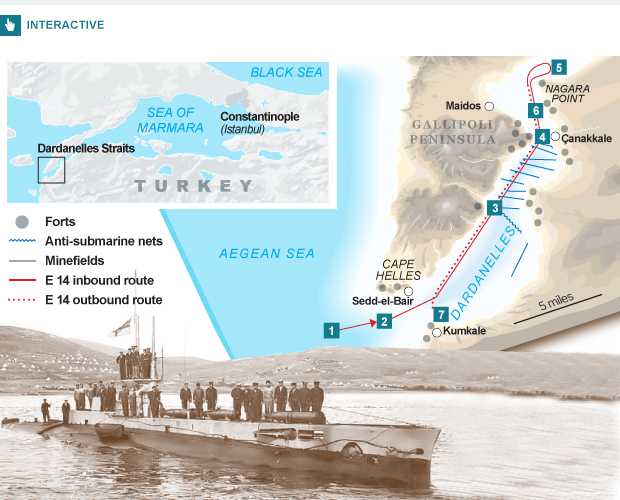The first pictures of the First World War submarine E14 on the sea bed off Turkey show that the wreck looks intact, suggesting the remains of the crew are inside.
By Jasper Copping
9:00AM BST 17 Jun 2012

She is a vessel unique in the history of the Royal Navy – the only one in which two captains won the Victoria Cross for their exploits aboard.
Now the submarine HMS E14 has been photographed in her final resting place, 94 years after she went down under heavy shellfire during the First World War.
The first pictures of the vessel on the ocean bed show her looking largely intact, suggesting the remains of the crew and their personal effects are still inside. The precise location of the wreck in the eastern Mediterranean was a mystery until it was discovered by Turkish divers this month.
The British government has been informed of the discovery and is due to raise the matter with the Turkish authorities to ensure the site is properly preserved as a war grave.
E14 sank in January 1918, with the loss of 25 lives, after she was sent around 20 miles into the heavily fortified Dardanelles, the narrow straits between modern-day Turkey’s European and Asian coasts, to torpedo the flagship of the Ottoman empire’s navy.
She navigated through dense minefields and past a string of enemy forts on both shores but when her captain, Lieutenant-Commander Geoffrey White, found that his target was not where it was expected to be, he instead attacked another enemy vessel in their path. However, one of the torpedoes exploded prematurely, damaging E14 and alerting Ottoman forces along the coast to the submarine’s presence.
White headed back down the straits towards safety but was eventually forced to surface the craft after her controls became unresponsive and the air on board began to run out.
The vessel was instantly battered by intense bombardment by guns from both sides of the straits, but White left the comparative safety of the boat’s hull to go up on deck to navigate.
Realising the submarine could not reach the open sea, he directed her towards a nearby beach, in an effort to save the crew. A survivor recalled that his last words were – “We are in the hands of God”, uttered moments before he was killed by a shell and the submarine went under.
For his actions, he was posthumously awarded the VC. Only seven of E14’s 32 crew managed to escape from the stricken craft.
Three years earlier, during the Gallipoli Campaign – the allied landings on the coast at the end of the Dardanelles – the same vessel conducted a daring raid through the straits, past dense minefields and deep into enemy territory, in the Sea of Marmara.
Once there, the submarine dodged hostile patrols and caused havoc among enemy shipping for several days, sinking an Ottoman gunboat and a former White Star liner converted to a troop ship, and disabling another warship.
For that 1915 mission, her skipper, Lieutenant Commander Edward Boyle, was awarded the VC. He went on to make at least two more tours of the Sea of Marmara on E14, during the boat’s distinguished career.
The shipwreck was discovered by Selçuk Kolay, a Turkish marine engineer, and Savas Karakas, a diver and filmmaker, who have spent three years trying to find it.
They established the approximate location from studying documents kept at the National Archives, in Kew, west London, as well as surveying the positions of coastal defences. In 2010, they detected an unusual object on the seabed just off the town of Kum Kale while scanning it from a boat on the surface.
However, the wreck’s location – near the mouth of the straits – remains a strategically sensitive area, with a military installation on the nearby shore, and diving is forbidden.
It took a further two years to get permission from the Turkish military authorities before their team were able to dive to the wreck and confirm it as the E14 earlier this month.
The submarine was found at a depth of 65ft, around 800ft from the beach. It is lying at an angle of almost 45 degrees on the sloping seabed, and all but the front 23ft of the 181ft vessel is covered in sand.
While the wreck looks largely intact, at least one shell hole is visible near the bows, indicating the battering the submarine took.
Her location also suggests she was less than a quarter of a mile from getting out of the straits and out of the range of guns.
Mr Kolay said: “They were almost out of the Dardanelles and would have been safe. The wreck is in a good condition and is one of the best preserved submarines of its type left on the earth. It is of great historical significance, as well as being, of course, a war grave.”
Boyle, who was born in Carlisle and went to school at Cheltenham College, survived the war and also served in the Second World War, reaching the rank of rear admiral. He died in 1967 in Ascot, Berks, at the age of 84.
His Victoria Cross is displayed at the Royal Navy Submarine Museum, Gosport, Hants.
White was from Bromley, Kent, and had gone to school at Bradfield College, Reading. He was killed at the age of 31, leaving a widow, Sybil, and three children under the age of six.
His medal is now owned by his grandson, Richard Campbell, 60, from Pulborough, West Sussex, who keeps it in a bank.
“I have always felt that my grandmother is the only person who really had the right to sell it, if she wanted to,” he said. “It was very dear to her. She had great pride in it, without a doubt.”

Leave a Reply